Native Americans Helped Invent American Democracy But Are Often Prevented From Practicing It
From Utah and Arizona to the Dakotas, Indigenous communities struggle against efforts to suppress their ability to vote
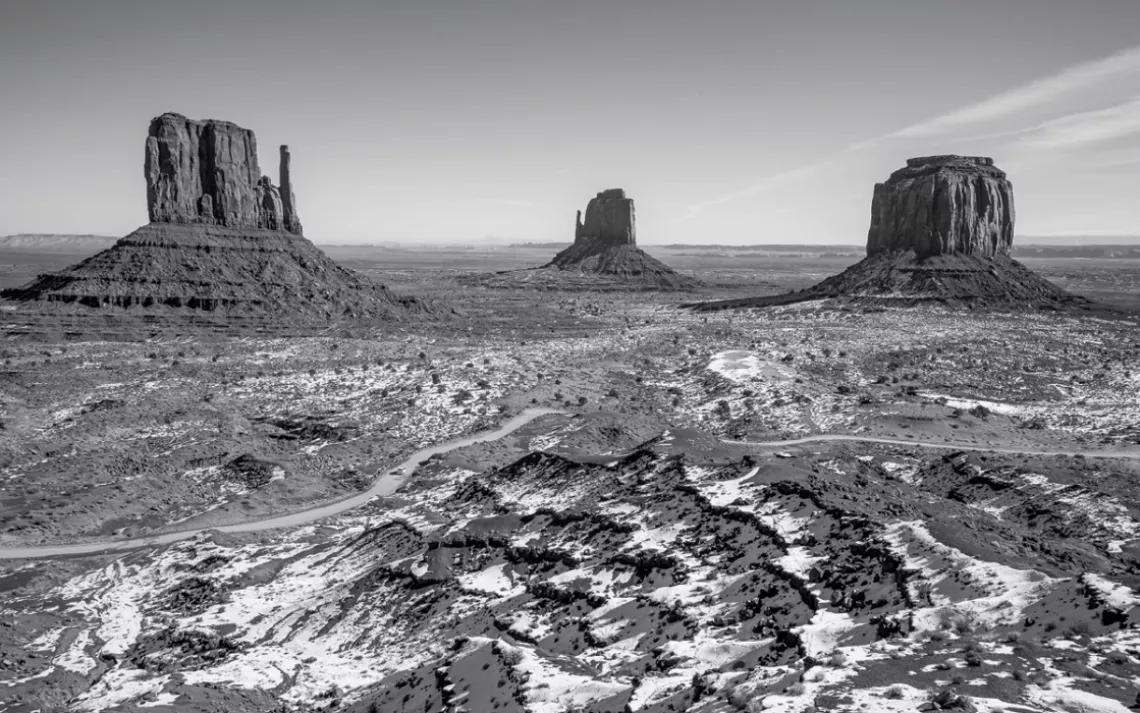
The sandstone buttes of Monument Valley have become synonymous with the Navajo Nation, whose members have always considered connection to place an essential piece of citizenship.
WILLIE GRAYEYES WAS BORN IN 1946 in San Juan County, Utah, in a small, isolated community not far from the base of Navajo Mountain. A striking dome of igneous rock rising 10,348 feet above sea level, Navajo Mountain is the highest point within the Navajo Nation, which sprawls across parts of Arizona, New Mexico, and Utah and, at some 27,000 square miles, is roughly the size of Ireland. In Navajo, the mountain is called Naatsis'áán (head of the earth), a reference to the sacred female, and it plays an important role in the culture and history of the Diné, as we Navajo refer to ourselves. In our creation stories, the mountain is home to the exploits of the Monster Slayer, who helped make the world safe for people. In the 1860s, the mountain's rugged flanks served as a hideout for the resistance warrior Chief Hoskininni after several thousand Navajos were incarcerated at Bosque Redondo. The mountain is also an important site in the personal lore of Willie Grayeyes: It's where his umbilical cord is buried, beneath a collapsed wooden stockade that once served as his family's sheep corral. "This is the place where I was born," Grayeyes told me in a conversation years ago. "So I have ties with the earth there."
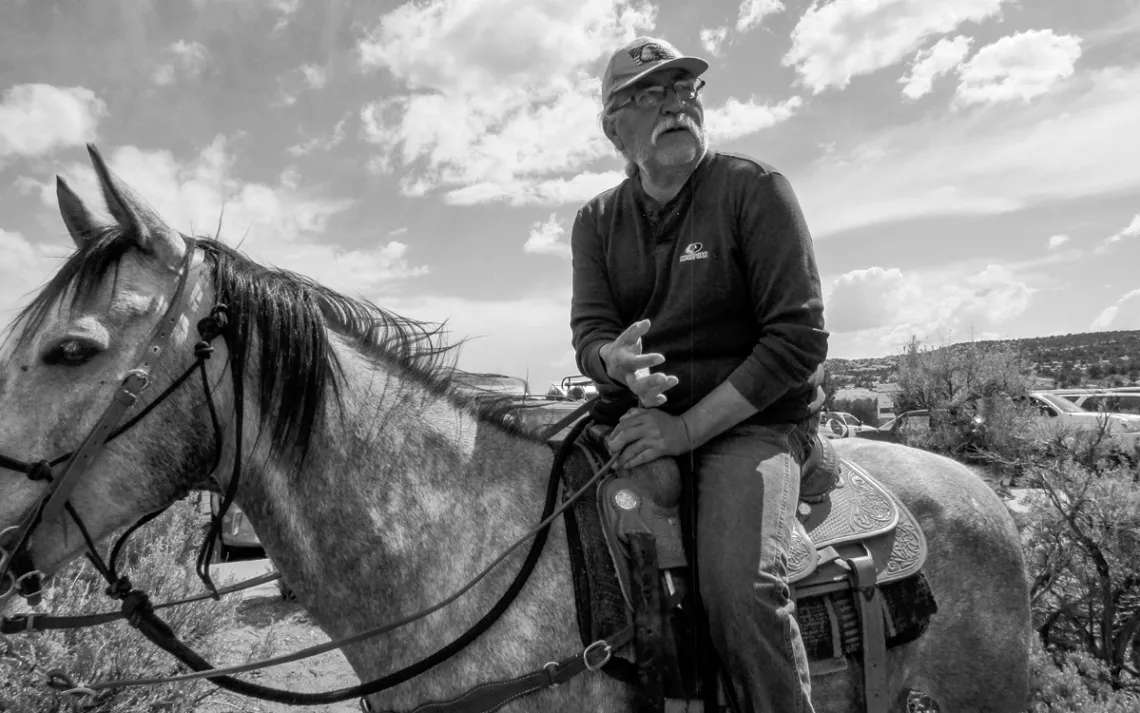
Willie Grayeyes had to prove his Utah residency in court to serve in public office. | Photo by Judy Fahys/KUER
The importance that Grayeyes has attached to the burial site may appear, to those ignorant of Diné culture, merely sentimental. Not long ago, however, the site of Grayeyes's umbilical cord served as evidence in a court case to prove where, exactly, he lives—a case that tested cross-cultural understandings of the meanings of home and place and revealed the challenges that some Navajos face in trying to exercise their rights as US citizens.
For decades, the Navajo residents of San Juan County have struggled against unequal political representation. In 1983, the US Department of Justice filed a complaint against the county, arguing that its system of "at large voting" disproportionately favored white candidates for office. The county responded by drawing three geographical districts, but the problem persisted. By the 2010 census, more than half the population of San Juan County was Native American or mixed race. Yet the county commission and the school board remained dominated by whites. In 2012, the Navajo Nation Human Rights Commission filed a lawsuit under the Voting Rights Act alleging that the county had been effectively gerrymandered by race. "We decided to sue because they weren't listening to us. They didn't accept our genuine effort to work together at that time," Leonard Gorman, the executive director of the human rights commission, told me. "Our office demonstrated that we had the numbers to have two Native Americans seated on the county commission."
On several occasions, the Diné plaintiffs offered to settle the lawsuit with San Juan County ("We were very transparent with them," Gorman said), but the county leadership refused. Finally, after years of expensive litigation, in 2017 a federal court ruled that the electoral districts violated the Voting Rights Act and would have to be redrawn. Noting that there had been no time in San Juan County history when whites didn't control the county commission and the school board, US district court judge Robert Shelby wrote, "It is critically important that the officials representing the citizens of San Juan County are elected under constitutional districts—not districts that have been racially gerrymandered." The new political lines meant that Navajos would be a majority of voters in two of the three county commission districts and three of the five school board districts.
Grayeyes had run for the county commission before and lost—in 2012, when, in his words, the white minority was "monopolizing county elections." The freshly drawn districts offered a new chance to make a bid for the county office. Grayeyes's 2018 candidacy was, in part, a response to President Donald Trump's efforts to abolish nearby Bears Ears National Monument. Grayeyes had been a board member of Utah Diné Bikéyah, the Indigenous-led grassroots organization that had spearheaded the campaign for the monument, and he was angered by the way the San Juan County commissioners—his local elected officials—were working with the Trump administration to wipe Bears Ears off the map.
Grayeyes's candidacy was also an effort to address the county's persistent inequities. San Juan County stretches across a landscape of red sandstone and high desert that's larger than Connecticut yet home to just 15,000 people. Generations of unfair political representation have left a mark on the place. In white-majority towns like Blanding and Monticello, there are new schools, city swimming pools, and modern health clinics. In Navajo-majority communities, basic services are sparse or nonexistent. The Navajo community of Westwater, for example, is located right across a canyon from Blanding, yet Westwater residents have no electricity or running water. Road conditions tell their own story. Most of the paved roads are clustered around the white-majority communities. Meanwhile, Highway 1919, a county-maintained road used mostly by Navajo residents, has deteriorated to the point that children whose families use the road to take them to school have complained of headaches and fatigue caused by the rough ride.
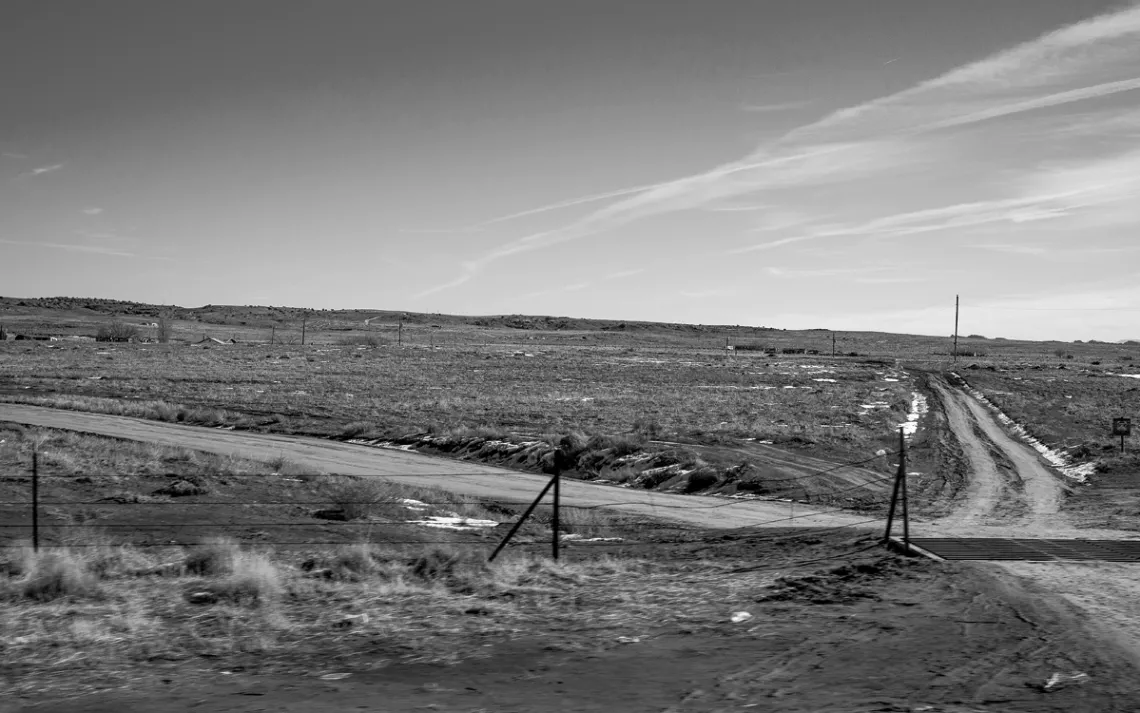
Poorly maintained roads complicate life for many Navajos.
On election night, Grayeyes celebrated a victory. Another Navajo proponent of Bears Ears National Monument, Kenneth Maryboy, was also elected to the commission. For the first time ever, the San Juan County Commission would have a Native American majority.
But less than two months after the election, Grayeyes's defeated opponent, a resident of Blanding named Kelly Laws, filed a legal challenge questioning whether Grayeyes was really a San Juan County resident. According to Laws, Grayeyes lived in Page, Arizona. It was the second time that his residency had been challenged; a similar claim came up during the election campaign but was dismissed by a judge.
Ironically, the confusion about Grayeyes's residency stemmed from the very inequities he had campaigned against. While raising his children decades earlier, Grayeyes had purchased a trailer in Arizona so they could go to school there—because San Juan County had so badly neglected the schools in Navajo areas. Grayeyes maintained, however, that he continued to live primarily at Navajo Mountain, that he took care of livestock there and represented the area within the tribal government.
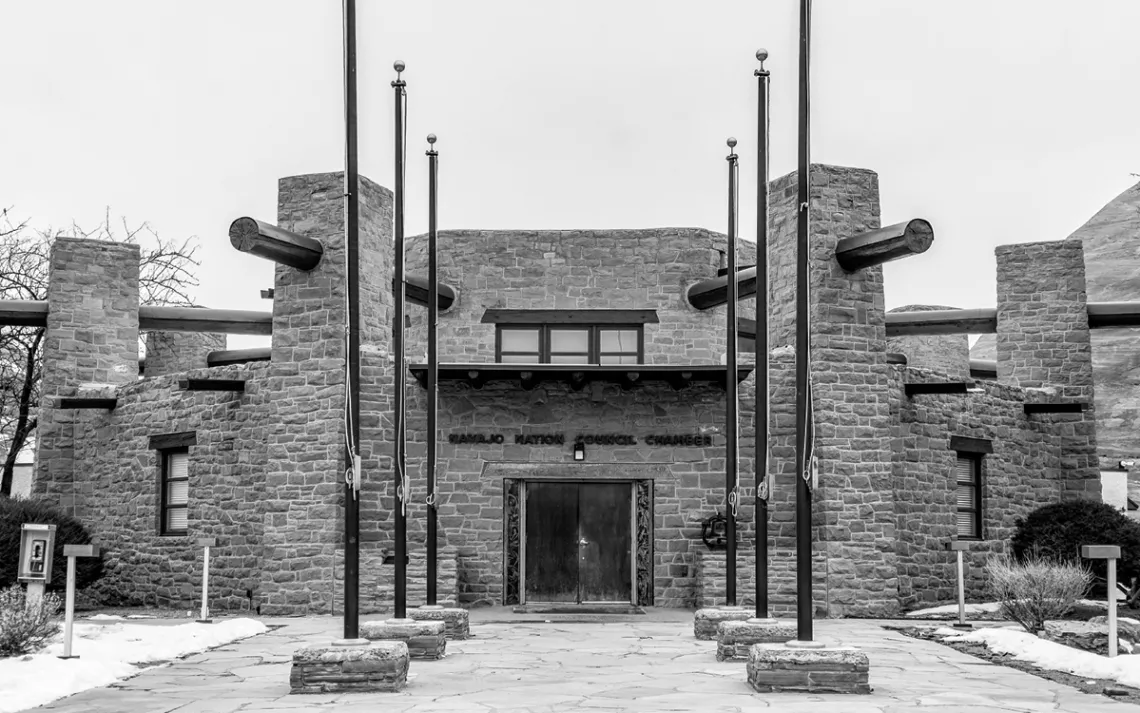
The Navajo Nation Council building
The court agreed. "He is connected to San Juan County as deeply as any resident of the county," federal district judge Don Torgerson ruled after hearing the case. "And his rich cultural history adds to his connection—he has always returned to the area and will always intend to return to the area when he has traveled away."
Although the opposing attorneys repeatedly (and unsuccessfully) argued to the judge that cultural beliefs should have no bearing on the residency question, the site of Grayeyes's umbilical cord was a key part of his case. In Navajo culture, the burial is considered a form of prayer, ensuring that as a child grows, the umbilical cord will strengthen their ties to family, land, and the community. During the court hearing, several Navajo elders testified about the connection between one's umbilical cord and one's place of residence. As Navajo Nation president Jonathan Nez told me in an interview, "our permanent residency is where our umbilical cord is buried."
On the day the historic Navajo majority was sworn in, Commissioner Maryboy said to the crowd that he knew it was "a culture shock for most of you that we have two Native Americans sitting on the county seat." And, in fact, it was a culture shock for many of the county's white residents. As one Anglo resident of Blanding told The Salt Lake Tribune even before Grayeyes was elected, "I feel like I've been disenfranchised."
DISENFRANCHISEMENT IS, of course, nothing new for Native Americans. The Indigenous peoples of the United States weren't granted full citizenship until 1924, and even then, many states resisted extending the right to vote to Native Americans for decades. In Arizona and New Mexico, Indigenous peoples had to resort to litigation to force those states to recognize their right to vote, which they finally did in 1948. Native Americans living on reservations in Utah didn't gain the right to vote until 1957, and in North Dakota, not until 1958.
Today, Native Americans' political participation is marked by a kind of paradox. In some states, Indigenous peoples are a crucial voting bloc that can swing the course of an election. A review by the National Congress of American Indians showed that between 2000 and 2018, the Native vote played a decisive role in US Senate races in Alaska, Montana, Oklahoma, North Dakota, South Dakota, and Washington. At the same time, the voter turnout of Native Americans is the lowest among all ethnic groups. According to a report from the Native American Voting Rights Coalition, "a variety of problems" keep Indigenous people from voting in greater numbers, including low levels of trust in government, lack of information about how and where to vote, and long travel distances to polling places.
In some cases, low voter turnout isn't just an issue of structural inequalities but is the result of open hostility to Native Americans and attempts to suppress their right to vote. North Dakota is a case in point.
Between 2013 and 2015, North Dakota legislators passed a pair of voter ID laws that dramatically narrowed the options for forms of identification that would be accepted at polling stations. The new rules included a provision stating that only IDs with a residential address could be used for voting. To many people, this seemed an obvious attempt to suppress the Native vote—since many Native Americans live in far-flung rural areas where there aren't any street addresses and where most people rely on post office boxes for their mail service. The stricter voting rules appeared to target the state's Democratic US senator, Heidi Heitkamp. In 2012, Heitkamp won her seat by a razor-thin margin of 3,000 votes. Native American voters, who represent more than 5 percent of the North Dakota electorate, were key to that victory.
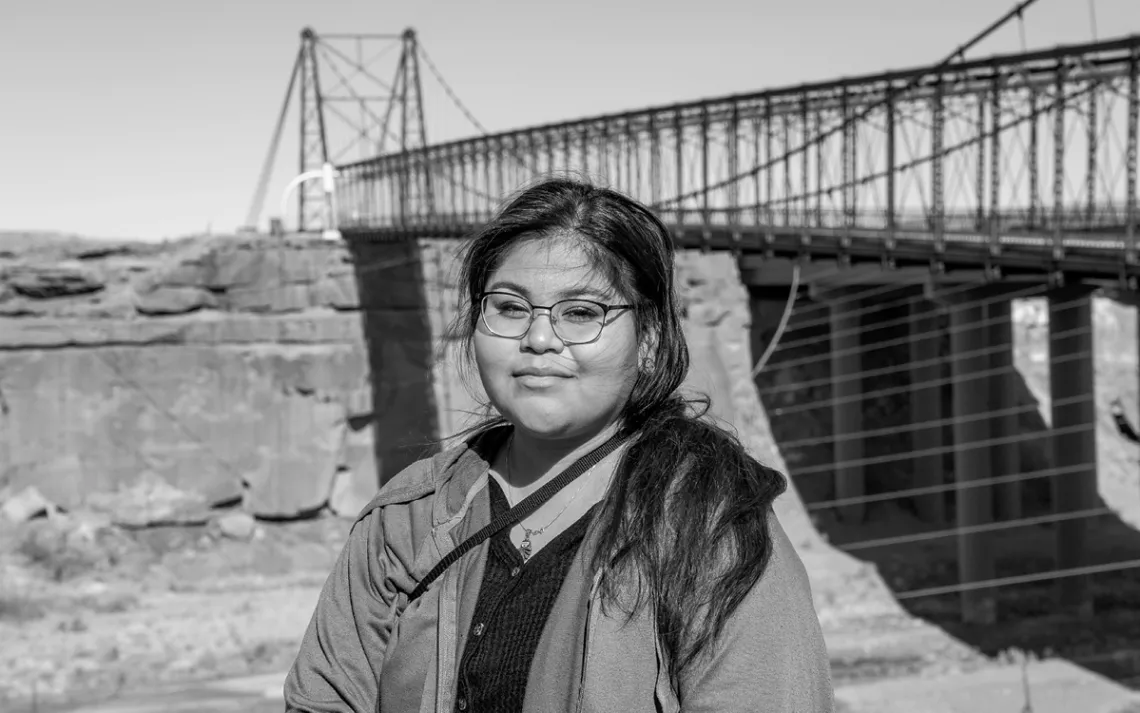
College student and environmental activist Lisa Semallie-Robbins
Members of the Turtle Mountain Band of Chippewa who had been prevented from voting sued to overturn the voter ID laws. In 2016, a federal judge reversed the new ID restrictions. The following year, the North Dakota legislature passed a revised voter ID law that addressed the court's concerns. The Chippewa plaintiffs sued again, and this time their case went all the way to the US Supreme Court. In October 2018—on the eve of the midterm elections—the US Supreme Court upheld the law.
Meanwhile, in the lead-up to the midterm elections, Native American civic groups and tribal leadership in North Dakota engaged in a variety of strategies and tactics to make sure Indigenous voters could cast a ballot. Four Directions, a Native voting rights advocacy group, launched an effort to update people's voting information with street addresses. The organization worked with Claremont Graduate University to develop software that tapped the addresses used by emergency vehicles to create street addresses for people. The system allowed voters, on Election Day, to point to their place of residence on an electronic map and generate a street address. Tribal officials at the polling places could then create tribal IDs with those addresses. (North Dakota is one of the few states that don't require pre-Election Day voter registration.) In the Standing Rock Sioux Reservation—where many tribal members had been politicized by the campaign against the Dakota Access Pipeline—tribal leaders and activists launched a reservation-wide get-out-the-vote campaign. The Turtle Mountain Band of Chippewa undertook a similar voter mobilization drive.
In some ways, the blatant attempt to suppress the Native American vote backfired. In the Standing Rock reservation, voter turnout more than doubled compared with the previous midterm election—rising from 694 voters to 1,423 voters. In the Turtle Mountain reservation, voter turnout increased by 40 percent. But it wasn't enough. Heitkamp, who had prioritized Native American rights during her time in the Senate, was defeated.
WHEN NATIVE AMERICANS DO SUCCEED in exercising their political power, there can be a backlash from entrenched interests. That's what happened in San Juan County after the election of Grayeyes and Maryboy gave the county commission its first-ever Navajo majority.
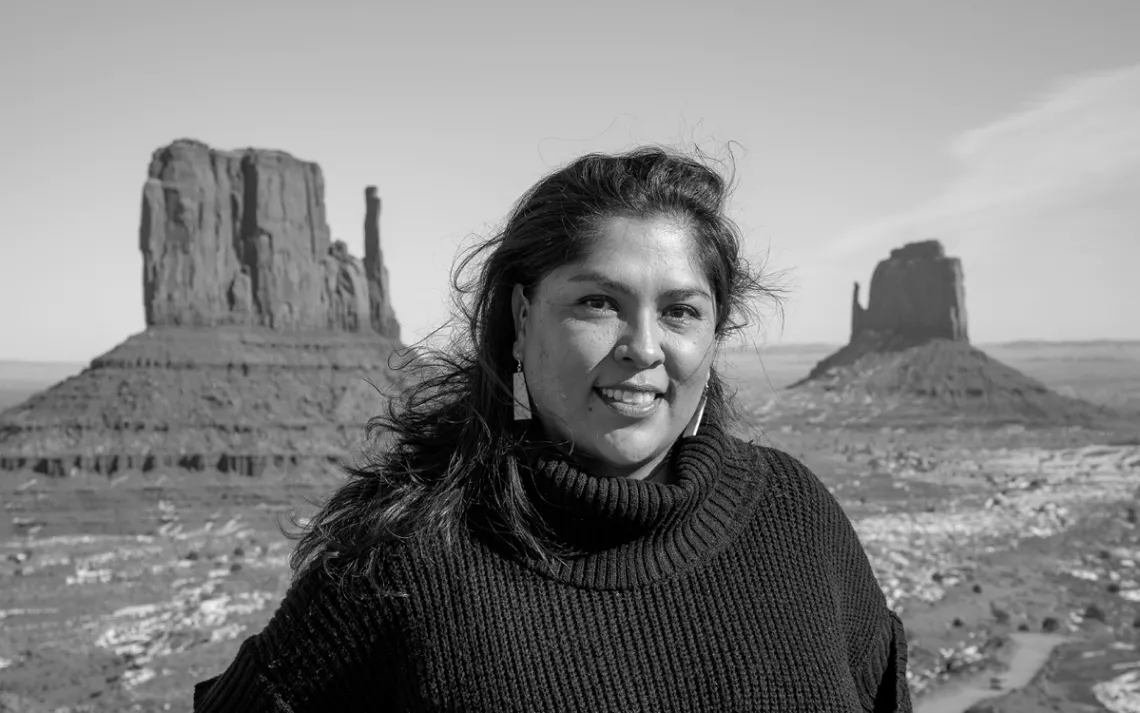
Navajo activist Davina Smith spearheaded a campaign in San Juan County, Utah, to prevent the dilution of Native American political power.
In early 2019, the mayor of Blanding proposed holding a special election to decide whether to expand the county commission to a greater number of seats. The move appeared to be an attempt to shift the balance of power away from Navajo voters, and it took many people by surprise, including Davina Smith, a Diné activist with the county's Democratic Party: "Every family that I've engaged [said things] like ‘We got this in the mail, but I'm not sure what it is because all the mailing said was that it was a study committee and a change of the form of government.'" Smith's family has long been involved with political activism (her grandmother was a forceful advocate against coal and uranium mining in the region), and she felt that her efforts to halt the proposed change in county governance were a continuation of that larger struggle. To her, the motives were obvious: "They [the county's white residents] feel they've had this power for so long, and they have that control."
In the months leading up to the November 2019 special election, Smith put countless miles on her car, crisscrossing San Juan County and speaking at Navajo chapter houses about the measure (the Navajo Nation is divided into 110 chapters). The Navajo-led Rural Utah Project also organized against the proposal, titled Proposition 10.
The grassroots campaign worked. On Election Day, the proposition was defeated 52 to 48 percent. The victory left Smith, as she said at the time, "smiling from ear to ear."
But the hard-won victory revealed another barrier that can keep Native Americans from voting: the complexities of vote-by-mail systems. Like much of Utah, San Juan County requires voters to cast their ballots by mail. In 2016, the Navajo Nation Human Rights Commission, assisted by the ACLU, filed a Voting Rights Act lawsuit against the county, arguing that the vote-by-mail system made it difficult for Navajos to vote since it led to the closure of all the polling places. Also, Navajo is mostly an oral language, and voting by mail doesn't work well for people who don't read or speak English.
Voting by mail might appear to be a reasonable solution to the difficulties facing Navajo voters, some of whom might live a 100-mile-round-trip drive from the nearest polling site. But, like many other services, basic postal service can be scarce on Native American reservations. Obtaining a mailbox at one's residence can be close to impossible. PO boxes cost about $60 per year, and some people, especially young people, cannot afford them. Even those who do have PO boxes tend to travel long distances to get to their nearest post office, which is often small and open for limited hours. And if a voter has a PO box outside the voting precinct where they live, their ballot risks being rejected.
"I think the challenge of voting on the reservation has a lot to do with infrastructure and the way things like the roads are here," said Lisa Semallie-Robbins, a Diné College student who has been involved in environmental activism in and around the Navajo Nation. "A lot of those people are elderly people, and they're not able to come into the chapter and vote."
In an effort to ensure that every Native citizen who wants to vote is able to cast a ballot, activists in the Navajo Nation used to go door to door and chapter house to chapter house to collect batches of (properly signed and sealed) ballots and then take them all to the polling station or post office. But in 2016, Arizona passed legislation that made it illegal to engage in this kind of "ballot harvesting." According to the law's sponsor, a Republican from Scottsdale, it was designed to prevent "ballot abuse." Critics said that the real intention of the law was to suppress voting by people of color, including Native Americans.
Last January, a federal appeals court struck down the law. "For over a century, Arizona has repeatedly targeted its American Indian, Hispanic, and African American citizens, limiting or eliminating their ability to vote and to participate in the political process," the court majority ruled. "Criminalization of the collection of another person's ballot was enacted with discriminatory intent. . . . To the degree that there has been any fraud, it has been the false and race-based claims of the proponents of [the legislation]."
AMERICAN DEMOCRACY was inspired by Indigenous example. By the time the first Europeans appeared in the hardwood forests along the Hudson River (Muh-he-kun-ne-tuk in Mohican), the Haudenosaunee peoples had already been organized into a self-governing commonwealth for some 15 generations. This living model of democratic decision-making made a lasting impression on the English colonists. "For all their government is by the Council or advice of the sages," Benjamin Franklin wrote. "Hence they generally study oratory; the best speaker having the most influence."
The Haudenosaunee weren't the only Native Americans to rule themselves according to democratic principles. Across North America, pre-Columbian Indigenous societies were characterized by equality, mutual respect, and individual rights balanced against collective responsibilities. This is also true of the Navajo, who have always tried to follow what we call the Diné Fundamental Law.
The Diné Fundamental Law (Diné Bi Beenahaz'áanii) rests on four pillars: traditional law, customary law, natural law, and common law. In some ways, our laws mirror Western democratic ideals; in some key aspects, they go beyond them. Diné traditional law establishes that "it is the right and freedom of the Diné to choose leaders of their choice." According to the Navajo Supreme Court, "one fundamental value of Navajo society is complete equality among people." Under Diné natural law, this equality extends to nonhuman beings: "All creation, from Mother Earth and Father Sky to the animals, those who live in water, those who fly, and plant life have their own laws and have rights and freedom to exist."
Many Diné I have spoken to over the years have expressed hope that the revival of the Fundamental Law offers us a way to reconnect to the wisdom of our ancestors. Another hope is that our non-Native neighbors and fellow US citizens might find a way to learn from the example of our long-standing values. Among those lessons is the connection between right relationships among people and right relationships to place. "These lands offer a form of healing that we want people to accept so we can live in harmony together," Willie Grayeyes once told me, expressing his hope that dominant, white culture might find "a more harmonious approach than just hit-and-run."
"What are Navajo human rights?" Leonard Gorman said to me. "It's really, for us as Navajos, centered on place. . . . I think it's a form of a permanency situation. That, in our sense, we're here, and we're not going anywhere." He continued, "It's ingrained in me that this is my place. . . . That's the big difference in how we [Natives and non-Natives] deal with one another."
To be in a permanent relationship with place requires people to exhibit patience, deference, and trust—the very qualities that, for centuries, have been lacking in the relationships between the newcomers to this continent and its original inhabitants. Maybe someday, as Native Americans become a more powerful force in the political systems of the United States, the dominant culture might come to see the connection between place and politics, and might even find a way to practice the first principle of any democracy: respect.
This article appeared in the May/June 2020 edition with the headline "The Fundamental Law."
Dustin Wero is a Diné landscape photographer and outdoors protector from the Wandering People clan and Tangle People clan.
This article was funded by the Sierra Club Foundation.
 The Magazine of The Sierra Club
The Magazine of The Sierra Club



